University Nursing Case Study: Pancreatitis Assessment and Care Plan
VerifiedAdded on 2022/09/26
|14
|4085
|20
Case Study
AI Summary
This case study presents a comprehensive nursing assessment and care plan for Mr. John, a patient admitted to the emergency department with pancreatitis. The assessment covers various body systems, including the CNS, CVS, respiratory, abdominal, and renal systems, with detailed descriptions of assessment techniques and expected findings. The case study emphasizes the importance of systematic assessment in identifying treatment priorities, which include pain management using medications like Fentanyl and Ondansteron for nausea, as well as proton-pump inhibitors. The document also addresses the role of the nurse in medication administration, patient monitoring, and patient education, ensuring the principles of equity, self-determination, rights, and access are applied within the social justice framework. The case study provides insights into evidence-based nursing practices and the management of complex health needs, including a discharge plan aligned with social justice principles.

Case 1 Pancreatitis 1
Case 1 Pancreatic
By
Course
Professor
University
City
Date
Case 1 Pancreatic
By
Course
Professor
University
City
Date
Paraphrase This Document
Need a fresh take? Get an instant paraphrase of this document with our AI Paraphraser
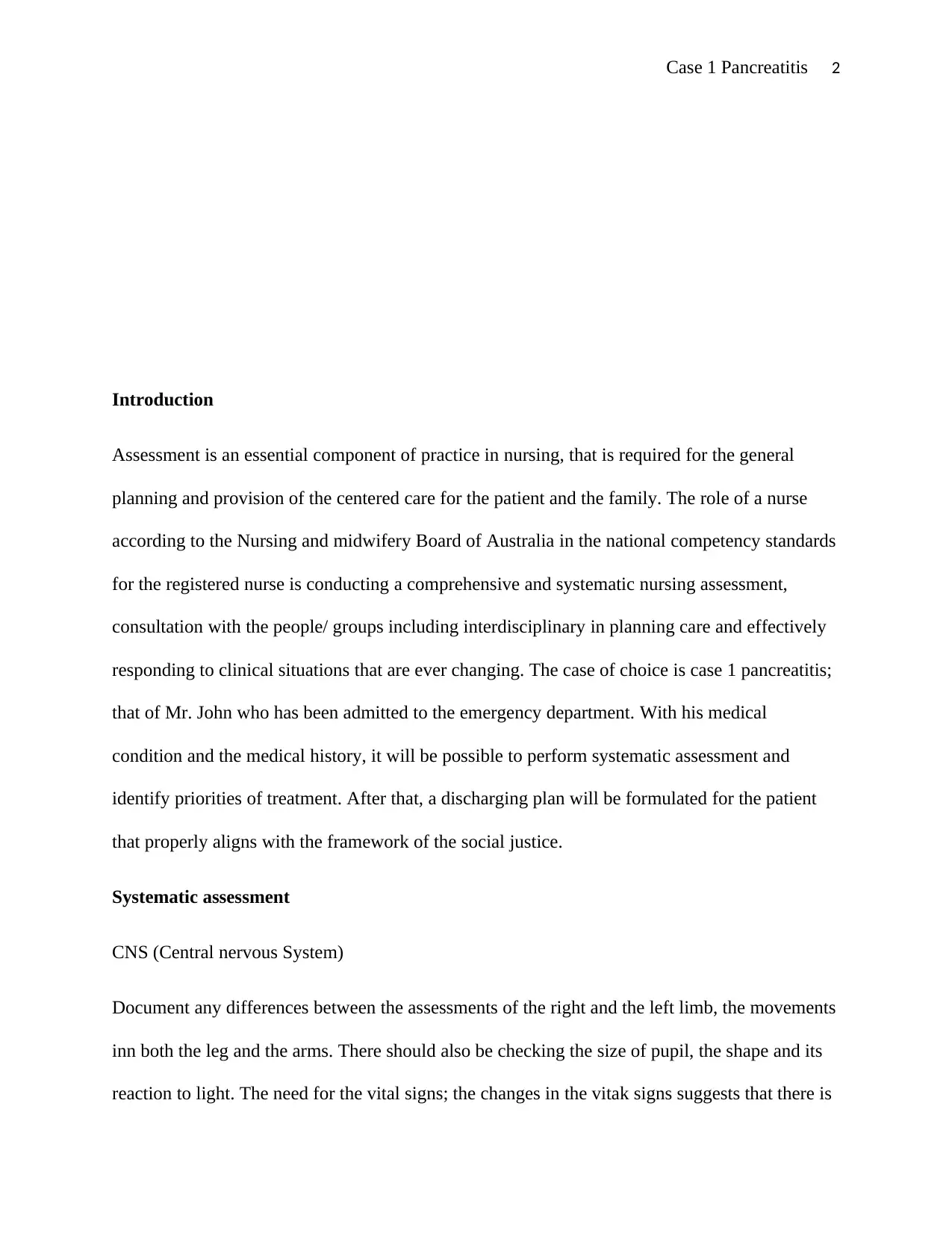
Case 1 Pancreatitis 2
Introduction
Assessment is an essential component of practice in nursing, that is required for the general
planning and provision of the centered care for the patient and the family. The role of a nurse
according to the Nursing and midwifery Board of Australia in the national competency standards
for the registered nurse is conducting a comprehensive and systematic nursing assessment,
consultation with the people/ groups including interdisciplinary in planning care and effectively
responding to clinical situations that are ever changing. The case of choice is case 1 pancreatitis;
that of Mr. John who has been admitted to the emergency department. With his medical
condition and the medical history, it will be possible to perform systematic assessment and
identify priorities of treatment. After that, a discharging plan will be formulated for the patient
that properly aligns with the framework of the social justice.
Systematic assessment
CNS (Central nervous System)
Document any differences between the assessments of the right and the left limb, the movements
inn both the leg and the arms. There should also be checking the size of pupil, the shape and its
reaction to light. The need for the vital signs; the changes in the vitak signs suggests that there is
Introduction
Assessment is an essential component of practice in nursing, that is required for the general
planning and provision of the centered care for the patient and the family. The role of a nurse
according to the Nursing and midwifery Board of Australia in the national competency standards
for the registered nurse is conducting a comprehensive and systematic nursing assessment,
consultation with the people/ groups including interdisciplinary in planning care and effectively
responding to clinical situations that are ever changing. The case of choice is case 1 pancreatitis;
that of Mr. John who has been admitted to the emergency department. With his medical
condition and the medical history, it will be possible to perform systematic assessment and
identify priorities of treatment. After that, a discharging plan will be formulated for the patient
that properly aligns with the framework of the social justice.
Systematic assessment
CNS (Central nervous System)
Document any differences between the assessments of the right and the left limb, the movements
inn both the leg and the arms. There should also be checking the size of pupil, the shape and its
reaction to light. The need for the vital signs; the changes in the vitak signs suggests that there is
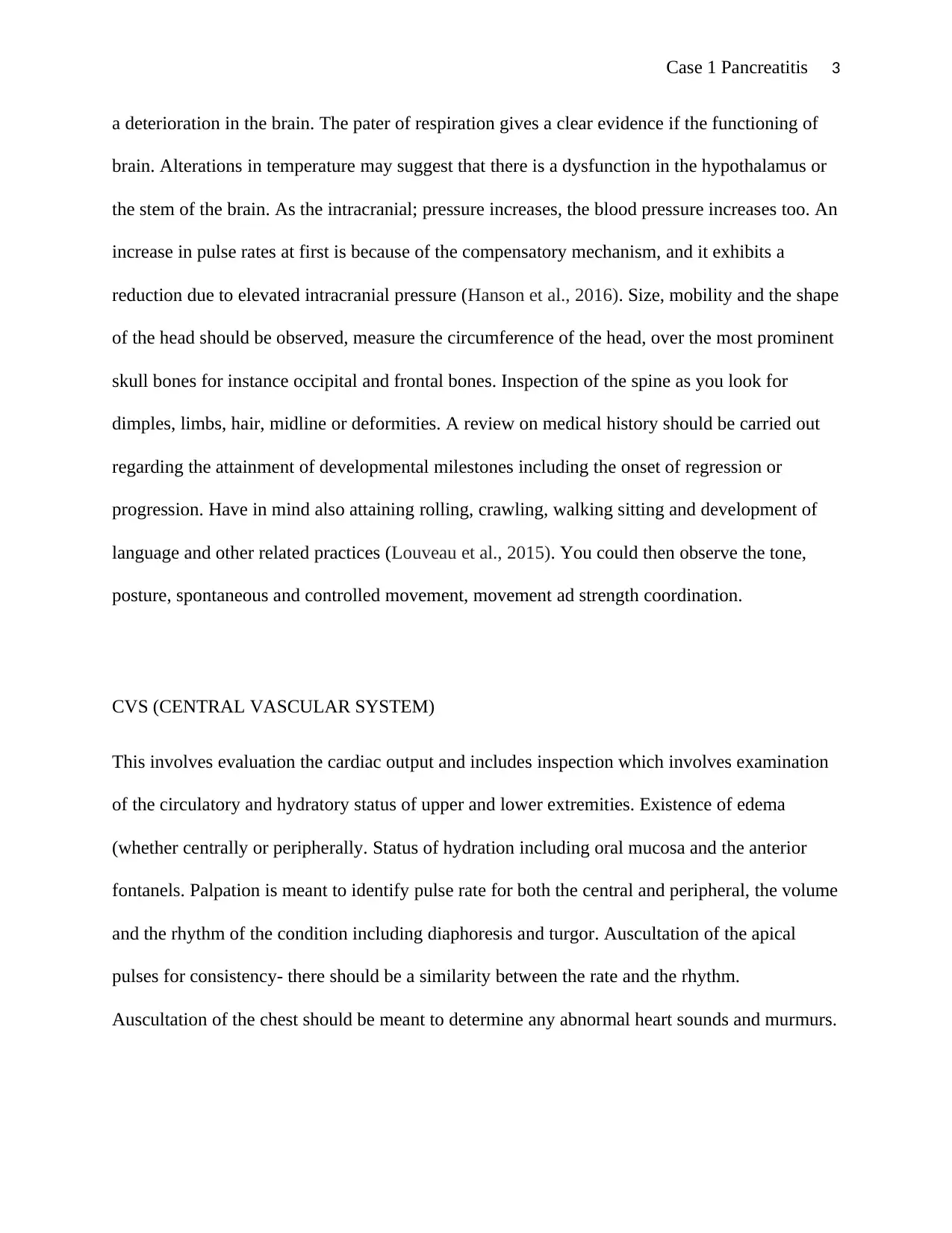
Case 1 Pancreatitis 3
a deterioration in the brain. The pater of respiration gives a clear evidence if the functioning of
brain. Alterations in temperature may suggest that there is a dysfunction in the hypothalamus or
the stem of the brain. As the intracranial; pressure increases, the blood pressure increases too. An
increase in pulse rates at first is because of the compensatory mechanism, and it exhibits a
reduction due to elevated intracranial pressure (Hanson et al., 2016). Size, mobility and the shape
of the head should be observed, measure the circumference of the head, over the most prominent
skull bones for instance occipital and frontal bones. Inspection of the spine as you look for
dimples, limbs, hair, midline or deformities. A review on medical history should be carried out
regarding the attainment of developmental milestones including the onset of regression or
progression. Have in mind also attaining rolling, crawling, walking sitting and development of
language and other related practices (Louveau et al., 2015). You could then observe the tone,
posture, spontaneous and controlled movement, movement ad strength coordination.
CVS (CENTRAL VASCULAR SYSTEM)
This involves evaluation the cardiac output and includes inspection which involves examination
of the circulatory and hydratory status of upper and lower extremities. Existence of edema
(whether centrally or peripherally. Status of hydration including oral mucosa and the anterior
fontanels. Palpation is meant to identify pulse rate for both the central and peripheral, the volume
and the rhythm of the condition including diaphoresis and turgor. Auscultation of the apical
pulses for consistency- there should be a similarity between the rate and the rhythm.
Auscultation of the chest should be meant to determine any abnormal heart sounds and murmurs.
a deterioration in the brain. The pater of respiration gives a clear evidence if the functioning of
brain. Alterations in temperature may suggest that there is a dysfunction in the hypothalamus or
the stem of the brain. As the intracranial; pressure increases, the blood pressure increases too. An
increase in pulse rates at first is because of the compensatory mechanism, and it exhibits a
reduction due to elevated intracranial pressure (Hanson et al., 2016). Size, mobility and the shape
of the head should be observed, measure the circumference of the head, over the most prominent
skull bones for instance occipital and frontal bones. Inspection of the spine as you look for
dimples, limbs, hair, midline or deformities. A review on medical history should be carried out
regarding the attainment of developmental milestones including the onset of regression or
progression. Have in mind also attaining rolling, crawling, walking sitting and development of
language and other related practices (Louveau et al., 2015). You could then observe the tone,
posture, spontaneous and controlled movement, movement ad strength coordination.
CVS (CENTRAL VASCULAR SYSTEM)
This involves evaluation the cardiac output and includes inspection which involves examination
of the circulatory and hydratory status of upper and lower extremities. Existence of edema
(whether centrally or peripherally. Status of hydration including oral mucosa and the anterior
fontanels. Palpation is meant to identify pulse rate for both the central and peripheral, the volume
and the rhythm of the condition including diaphoresis and turgor. Auscultation of the apical
pulses for consistency- there should be a similarity between the rate and the rhythm.
Auscultation of the chest should be meant to determine any abnormal heart sounds and murmurs.
⊘ This is a preview!⊘
Do you want full access?
Subscribe today to unlock all pages.

Trusted by 1+ million students worldwide
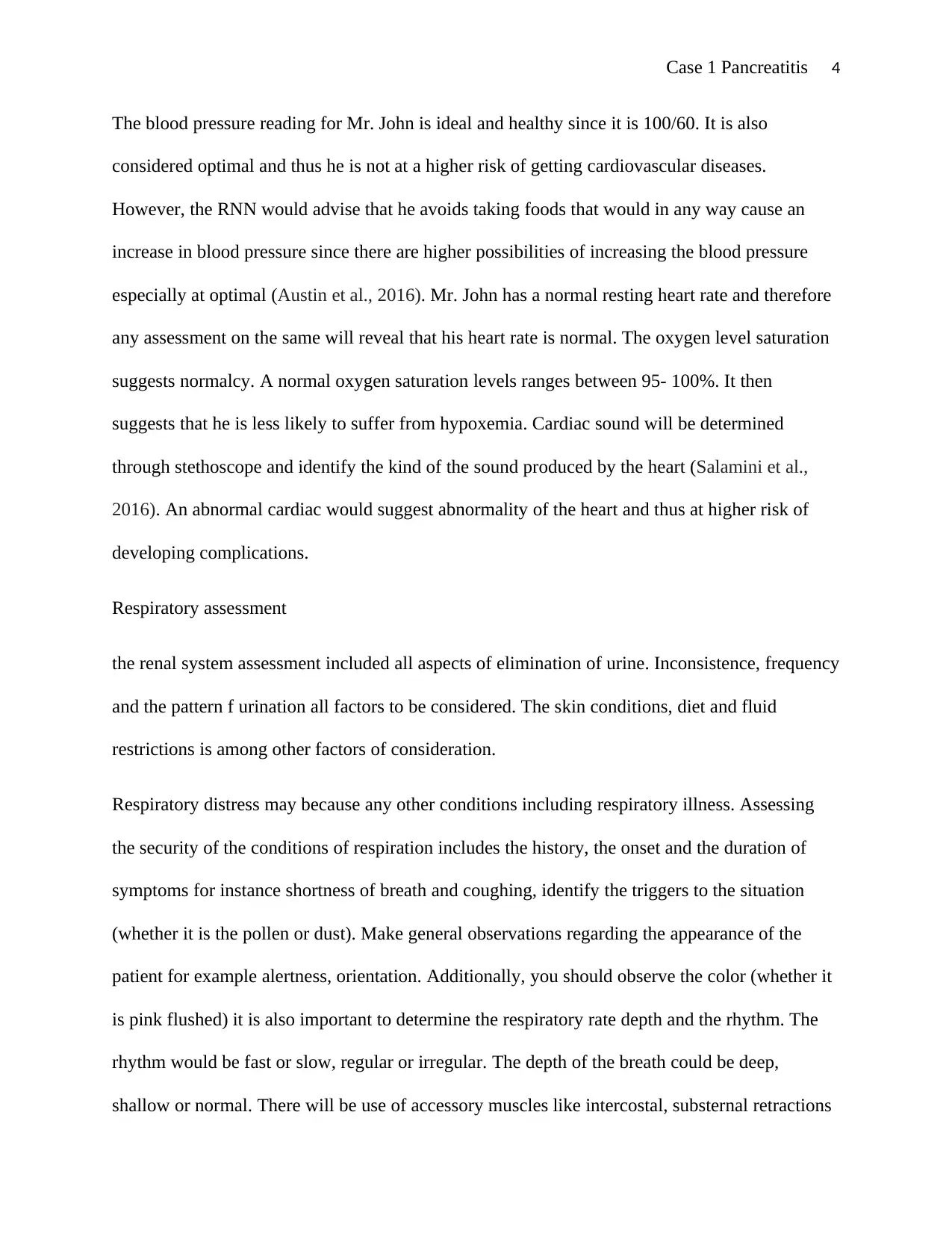
Case 1 Pancreatitis 4
The blood pressure reading for Mr. John is ideal and healthy since it is 100/60. It is also
considered optimal and thus he is not at a higher risk of getting cardiovascular diseases.
However, the RNN would advise that he avoids taking foods that would in any way cause an
increase in blood pressure since there are higher possibilities of increasing the blood pressure
especially at optimal (Austin et al., 2016). Mr. John has a normal resting heart rate and therefore
any assessment on the same will reveal that his heart rate is normal. The oxygen level saturation
suggests normalcy. A normal oxygen saturation levels ranges between 95- 100%. It then
suggests that he is less likely to suffer from hypoxemia. Cardiac sound will be determined
through stethoscope and identify the kind of the sound produced by the heart (Salamini et al.,
2016). An abnormal cardiac would suggest abnormality of the heart and thus at higher risk of
developing complications.
Respiratory assessment
the renal system assessment included all aspects of elimination of urine. Inconsistence, frequency
and the pattern f urination all factors to be considered. The skin conditions, diet and fluid
restrictions is among other factors of consideration.
Respiratory distress may because any other conditions including respiratory illness. Assessing
the security of the conditions of respiration includes the history, the onset and the duration of
symptoms for instance shortness of breath and coughing, identify the triggers to the situation
(whether it is the pollen or dust). Make general observations regarding the appearance of the
patient for example alertness, orientation. Additionally, you should observe the color (whether it
is pink flushed) it is also important to determine the respiratory rate depth and the rhythm. The
rhythm would be fast or slow, regular or irregular. The depth of the breath could be deep,
shallow or normal. There will be use of accessory muscles like intercostal, substernal retractions
The blood pressure reading for Mr. John is ideal and healthy since it is 100/60. It is also
considered optimal and thus he is not at a higher risk of getting cardiovascular diseases.
However, the RNN would advise that he avoids taking foods that would in any way cause an
increase in blood pressure since there are higher possibilities of increasing the blood pressure
especially at optimal (Austin et al., 2016). Mr. John has a normal resting heart rate and therefore
any assessment on the same will reveal that his heart rate is normal. The oxygen level saturation
suggests normalcy. A normal oxygen saturation levels ranges between 95- 100%. It then
suggests that he is less likely to suffer from hypoxemia. Cardiac sound will be determined
through stethoscope and identify the kind of the sound produced by the heart (Salamini et al.,
2016). An abnormal cardiac would suggest abnormality of the heart and thus at higher risk of
developing complications.
Respiratory assessment
the renal system assessment included all aspects of elimination of urine. Inconsistence, frequency
and the pattern f urination all factors to be considered. The skin conditions, diet and fluid
restrictions is among other factors of consideration.
Respiratory distress may because any other conditions including respiratory illness. Assessing
the security of the conditions of respiration includes the history, the onset and the duration of
symptoms for instance shortness of breath and coughing, identify the triggers to the situation
(whether it is the pollen or dust). Make general observations regarding the appearance of the
patient for example alertness, orientation. Additionally, you should observe the color (whether it
is pink flushed) it is also important to determine the respiratory rate depth and the rhythm. The
rhythm would be fast or slow, regular or irregular. The depth of the breath could be deep,
shallow or normal. There will be use of accessory muscles like intercostal, substernal retractions
Paraphrase This Document
Need a fresh take? Get an instant paraphrase of this document with our AI Paraphraser
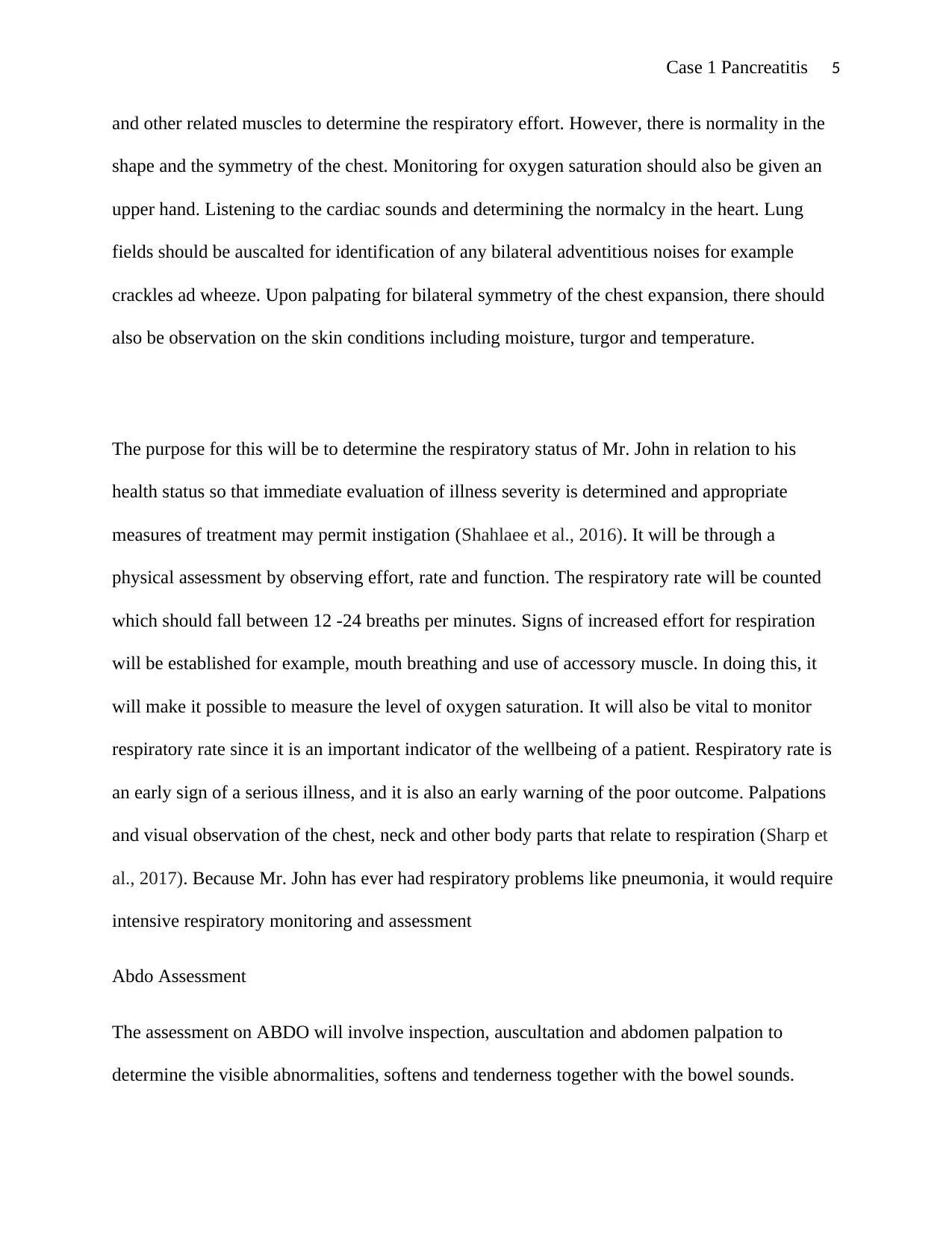
Case 1 Pancreatitis 5
and other related muscles to determine the respiratory effort. However, there is normality in the
shape and the symmetry of the chest. Monitoring for oxygen saturation should also be given an
upper hand. Listening to the cardiac sounds and determining the normalcy in the heart. Lung
fields should be auscalted for identification of any bilateral adventitious noises for example
crackles ad wheeze. Upon palpating for bilateral symmetry of the chest expansion, there should
also be observation on the skin conditions including moisture, turgor and temperature.
The purpose for this will be to determine the respiratory status of Mr. John in relation to his
health status so that immediate evaluation of illness severity is determined and appropriate
measures of treatment may permit instigation (Shahlaee et al., 2016). It will be through a
physical assessment by observing effort, rate and function. The respiratory rate will be counted
which should fall between 12 -24 breaths per minutes. Signs of increased effort for respiration
will be established for example, mouth breathing and use of accessory muscle. In doing this, it
will make it possible to measure the level of oxygen saturation. It will also be vital to monitor
respiratory rate since it is an important indicator of the wellbeing of a patient. Respiratory rate is
an early sign of a serious illness, and it is also an early warning of the poor outcome. Palpations
and visual observation of the chest, neck and other body parts that relate to respiration (Sharp et
al., 2017). Because Mr. John has ever had respiratory problems like pneumonia, it would require
intensive respiratory monitoring and assessment
Abdo Assessment
The assessment on ABDO will involve inspection, auscultation and abdomen palpation to
determine the visible abnormalities, softens and tenderness together with the bowel sounds.
and other related muscles to determine the respiratory effort. However, there is normality in the
shape and the symmetry of the chest. Monitoring for oxygen saturation should also be given an
upper hand. Listening to the cardiac sounds and determining the normalcy in the heart. Lung
fields should be auscalted for identification of any bilateral adventitious noises for example
crackles ad wheeze. Upon palpating for bilateral symmetry of the chest expansion, there should
also be observation on the skin conditions including moisture, turgor and temperature.
The purpose for this will be to determine the respiratory status of Mr. John in relation to his
health status so that immediate evaluation of illness severity is determined and appropriate
measures of treatment may permit instigation (Shahlaee et al., 2016). It will be through a
physical assessment by observing effort, rate and function. The respiratory rate will be counted
which should fall between 12 -24 breaths per minutes. Signs of increased effort for respiration
will be established for example, mouth breathing and use of accessory muscle. In doing this, it
will make it possible to measure the level of oxygen saturation. It will also be vital to monitor
respiratory rate since it is an important indicator of the wellbeing of a patient. Respiratory rate is
an early sign of a serious illness, and it is also an early warning of the poor outcome. Palpations
and visual observation of the chest, neck and other body parts that relate to respiration (Sharp et
al., 2017). Because Mr. John has ever had respiratory problems like pneumonia, it would require
intensive respiratory monitoring and assessment
Abdo Assessment
The assessment on ABDO will involve inspection, auscultation and abdomen palpation to
determine the visible abnormalities, softens and tenderness together with the bowel sounds.
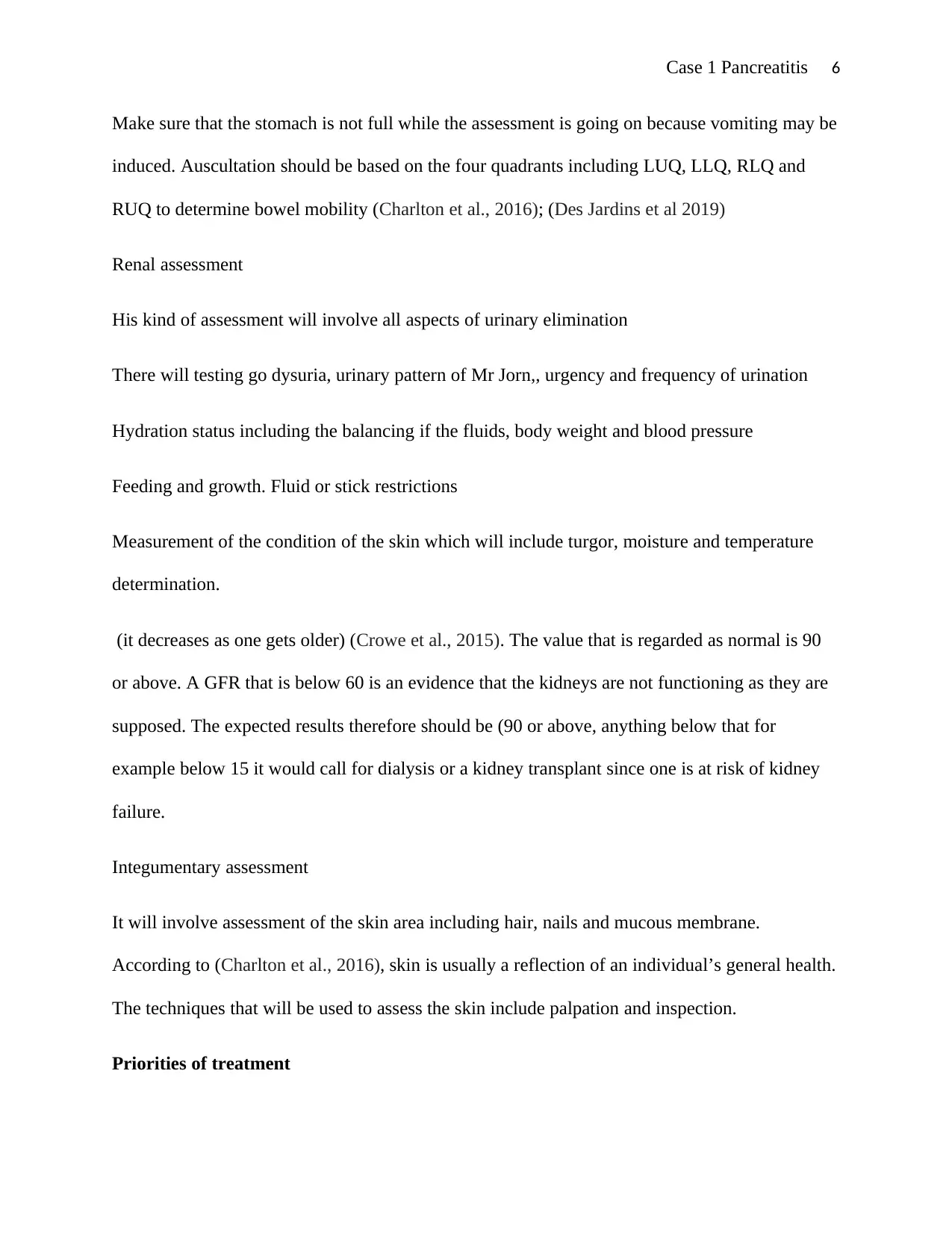
Case 1 Pancreatitis 6
Make sure that the stomach is not full while the assessment is going on because vomiting may be
induced. Auscultation should be based on the four quadrants including LUQ, LLQ, RLQ and
RUQ to determine bowel mobility (Charlton et al., 2016); (Des Jardins et al 2019)
Renal assessment
His kind of assessment will involve all aspects of urinary elimination
There will testing go dysuria, urinary pattern of Mr Jorn,, urgency and frequency of urination
Hydration status including the balancing if the fluids, body weight and blood pressure
Feeding and growth. Fluid or stick restrictions
Measurement of the condition of the skin which will include turgor, moisture and temperature
determination.
(it decreases as one gets older) (Crowe et al., 2015). The value that is regarded as normal is 90
or above. A GFR that is below 60 is an evidence that the kidneys are not functioning as they are
supposed. The expected results therefore should be (90 or above, anything below that for
example below 15 it would call for dialysis or a kidney transplant since one is at risk of kidney
failure.
Integumentary assessment
It will involve assessment of the skin area including hair, nails and mucous membrane.
According to (Charlton et al., 2016), skin is usually a reflection of an individual’s general health.
The techniques that will be used to assess the skin include palpation and inspection.
Priorities of treatment
Make sure that the stomach is not full while the assessment is going on because vomiting may be
induced. Auscultation should be based on the four quadrants including LUQ, LLQ, RLQ and
RUQ to determine bowel mobility (Charlton et al., 2016); (Des Jardins et al 2019)
Renal assessment
His kind of assessment will involve all aspects of urinary elimination
There will testing go dysuria, urinary pattern of Mr Jorn,, urgency and frequency of urination
Hydration status including the balancing if the fluids, body weight and blood pressure
Feeding and growth. Fluid or stick restrictions
Measurement of the condition of the skin which will include turgor, moisture and temperature
determination.
(it decreases as one gets older) (Crowe et al., 2015). The value that is regarded as normal is 90
or above. A GFR that is below 60 is an evidence that the kidneys are not functioning as they are
supposed. The expected results therefore should be (90 or above, anything below that for
example below 15 it would call for dialysis or a kidney transplant since one is at risk of kidney
failure.
Integumentary assessment
It will involve assessment of the skin area including hair, nails and mucous membrane.
According to (Charlton et al., 2016), skin is usually a reflection of an individual’s general health.
The techniques that will be used to assess the skin include palpation and inspection.
Priorities of treatment
⊘ This is a preview!⊘
Do you want full access?
Subscribe today to unlock all pages.

Trusted by 1+ million students worldwide
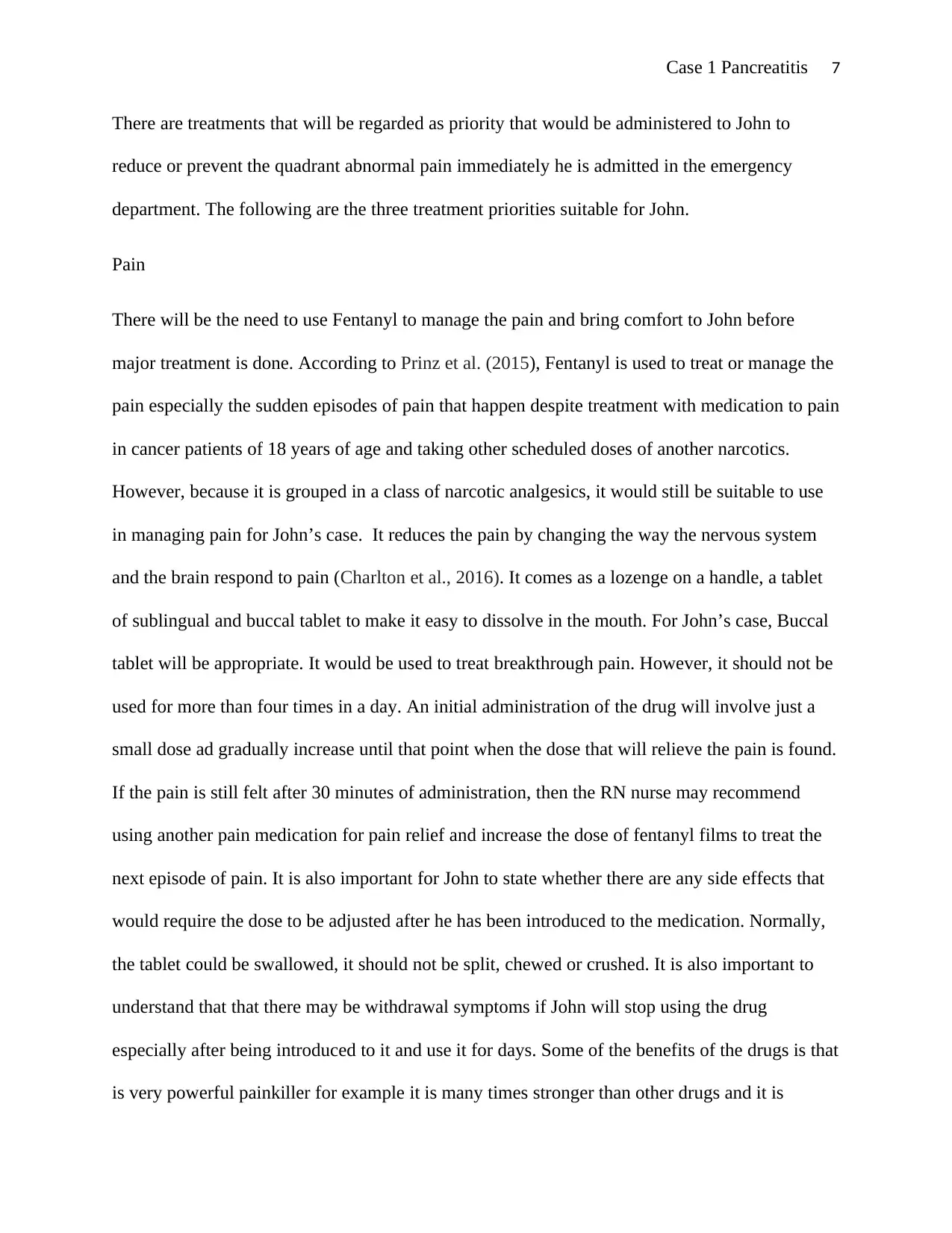
Case 1 Pancreatitis 7
There are treatments that will be regarded as priority that would be administered to John to
reduce or prevent the quadrant abnormal pain immediately he is admitted in the emergency
department. The following are the three treatment priorities suitable for John.
Pain
There will be the need to use Fentanyl to manage the pain and bring comfort to John before
major treatment is done. According to Prinz et al. (2015), Fentanyl is used to treat or manage the
pain especially the sudden episodes of pain that happen despite treatment with medication to pain
in cancer patients of 18 years of age and taking other scheduled doses of another narcotics.
However, because it is grouped in a class of narcotic analgesics, it would still be suitable to use
in managing pain for John’s case. It reduces the pain by changing the way the nervous system
and the brain respond to pain (Charlton et al., 2016). It comes as a lozenge on a handle, a tablet
of sublingual and buccal tablet to make it easy to dissolve in the mouth. For John’s case, Buccal
tablet will be appropriate. It would be used to treat breakthrough pain. However, it should not be
used for more than four times in a day. An initial administration of the drug will involve just a
small dose ad gradually increase until that point when the dose that will relieve the pain is found.
If the pain is still felt after 30 minutes of administration, then the RN nurse may recommend
using another pain medication for pain relief and increase the dose of fentanyl films to treat the
next episode of pain. It is also important for John to state whether there are any side effects that
would require the dose to be adjusted after he has been introduced to the medication. Normally,
the tablet could be swallowed, it should not be split, chewed or crushed. It is also important to
understand that that there may be withdrawal symptoms if John will stop using the drug
especially after being introduced to it and use it for days. Some of the benefits of the drugs is that
is very powerful painkiller for example it is many times stronger than other drugs and it is
There are treatments that will be regarded as priority that would be administered to John to
reduce or prevent the quadrant abnormal pain immediately he is admitted in the emergency
department. The following are the three treatment priorities suitable for John.
Pain
There will be the need to use Fentanyl to manage the pain and bring comfort to John before
major treatment is done. According to Prinz et al. (2015), Fentanyl is used to treat or manage the
pain especially the sudden episodes of pain that happen despite treatment with medication to pain
in cancer patients of 18 years of age and taking other scheduled doses of another narcotics.
However, because it is grouped in a class of narcotic analgesics, it would still be suitable to use
in managing pain for John’s case. It reduces the pain by changing the way the nervous system
and the brain respond to pain (Charlton et al., 2016). It comes as a lozenge on a handle, a tablet
of sublingual and buccal tablet to make it easy to dissolve in the mouth. For John’s case, Buccal
tablet will be appropriate. It would be used to treat breakthrough pain. However, it should not be
used for more than four times in a day. An initial administration of the drug will involve just a
small dose ad gradually increase until that point when the dose that will relieve the pain is found.
If the pain is still felt after 30 minutes of administration, then the RN nurse may recommend
using another pain medication for pain relief and increase the dose of fentanyl films to treat the
next episode of pain. It is also important for John to state whether there are any side effects that
would require the dose to be adjusted after he has been introduced to the medication. Normally,
the tablet could be swallowed, it should not be split, chewed or crushed. It is also important to
understand that that there may be withdrawal symptoms if John will stop using the drug
especially after being introduced to it and use it for days. Some of the benefits of the drugs is that
is very powerful painkiller for example it is many times stronger than other drugs and it is
Paraphrase This Document
Need a fresh take? Get an instant paraphrase of this document with our AI Paraphraser
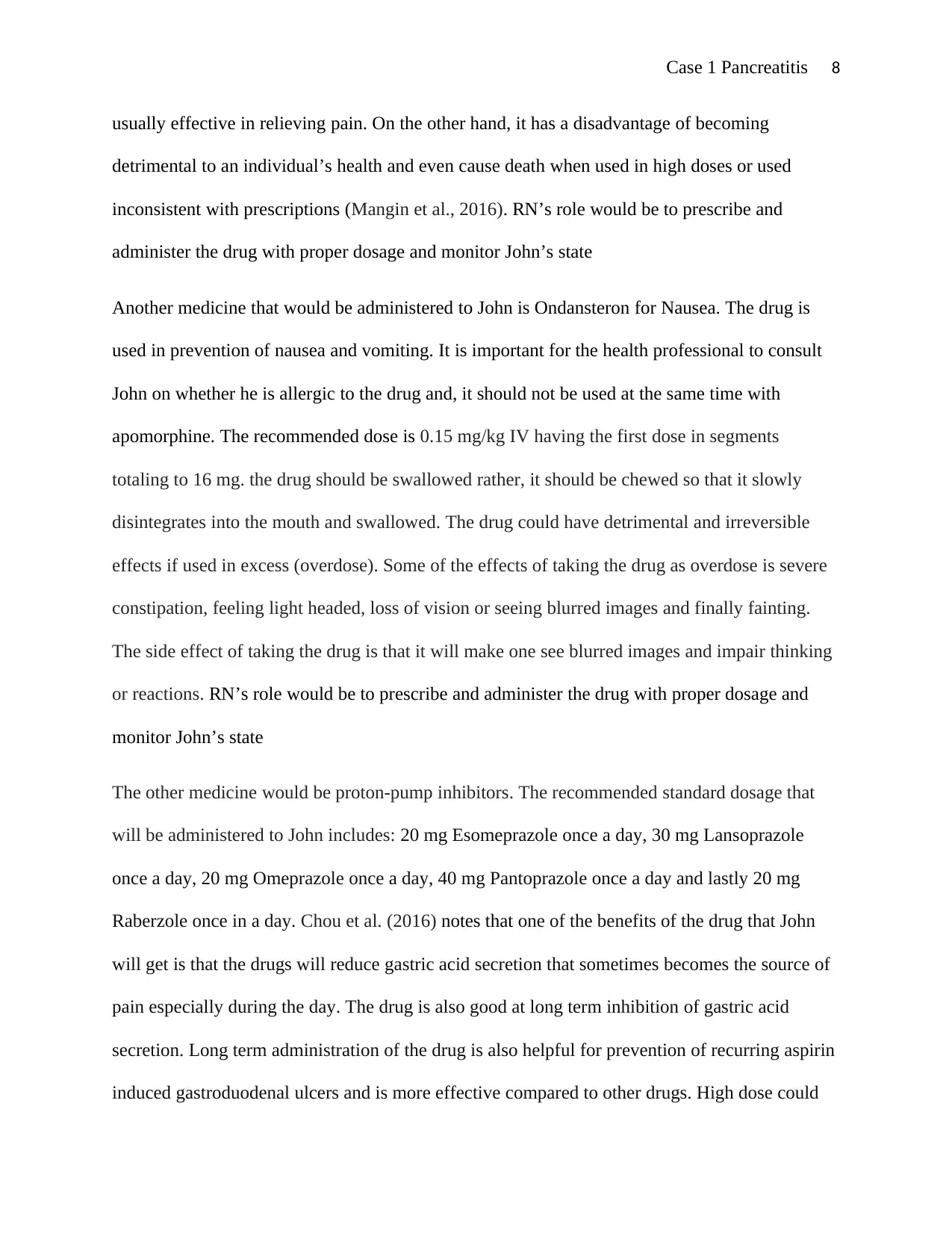
Case 1 Pancreatitis 8
usually effective in relieving pain. On the other hand, it has a disadvantage of becoming
detrimental to an individual’s health and even cause death when used in high doses or used
inconsistent with prescriptions (Mangin et al., 2016). RN’s role would be to prescribe and
administer the drug with proper dosage and monitor John’s state
Another medicine that would be administered to John is Ondansteron for Nausea. The drug is
used in prevention of nausea and vomiting. It is important for the health professional to consult
John on whether he is allergic to the drug and, it should not be used at the same time with
apomorphine. The recommended dose is 0.15 mg/kg IV having the first dose in segments
totaling to 16 mg. the drug should be swallowed rather, it should be chewed so that it slowly
disintegrates into the mouth and swallowed. The drug could have detrimental and irreversible
effects if used in excess (overdose). Some of the effects of taking the drug as overdose is severe
constipation, feeling light headed, loss of vision or seeing blurred images and finally fainting.
The side effect of taking the drug is that it will make one see blurred images and impair thinking
or reactions. RN’s role would be to prescribe and administer the drug with proper dosage and
monitor John’s state
The other medicine would be proton-pump inhibitors. The recommended standard dosage that
will be administered to John includes: 20 mg Esomeprazole once a day, 30 mg Lansoprazole
once a day, 20 mg Omeprazole once a day, 40 mg Pantoprazole once a day and lastly 20 mg
Raberzole once in a day. Chou et al. (2016) notes that one of the benefits of the drug that John
will get is that the drugs will reduce gastric acid secretion that sometimes becomes the source of
pain especially during the day. The drug is also good at long term inhibition of gastric acid
secretion. Long term administration of the drug is also helpful for prevention of recurring aspirin
induced gastroduodenal ulcers and is more effective compared to other drugs. High dose could
usually effective in relieving pain. On the other hand, it has a disadvantage of becoming
detrimental to an individual’s health and even cause death when used in high doses or used
inconsistent with prescriptions (Mangin et al., 2016). RN’s role would be to prescribe and
administer the drug with proper dosage and monitor John’s state
Another medicine that would be administered to John is Ondansteron for Nausea. The drug is
used in prevention of nausea and vomiting. It is important for the health professional to consult
John on whether he is allergic to the drug and, it should not be used at the same time with
apomorphine. The recommended dose is 0.15 mg/kg IV having the first dose in segments
totaling to 16 mg. the drug should be swallowed rather, it should be chewed so that it slowly
disintegrates into the mouth and swallowed. The drug could have detrimental and irreversible
effects if used in excess (overdose). Some of the effects of taking the drug as overdose is severe
constipation, feeling light headed, loss of vision or seeing blurred images and finally fainting.
The side effect of taking the drug is that it will make one see blurred images and impair thinking
or reactions. RN’s role would be to prescribe and administer the drug with proper dosage and
monitor John’s state
The other medicine would be proton-pump inhibitors. The recommended standard dosage that
will be administered to John includes: 20 mg Esomeprazole once a day, 30 mg Lansoprazole
once a day, 20 mg Omeprazole once a day, 40 mg Pantoprazole once a day and lastly 20 mg
Raberzole once in a day. Chou et al. (2016) notes that one of the benefits of the drug that John
will get is that the drugs will reduce gastric acid secretion that sometimes becomes the source of
pain especially during the day. The drug is also good at long term inhibition of gastric acid
secretion. Long term administration of the drug is also helpful for prevention of recurring aspirin
induced gastroduodenal ulcers and is more effective compared to other drugs. High dose could
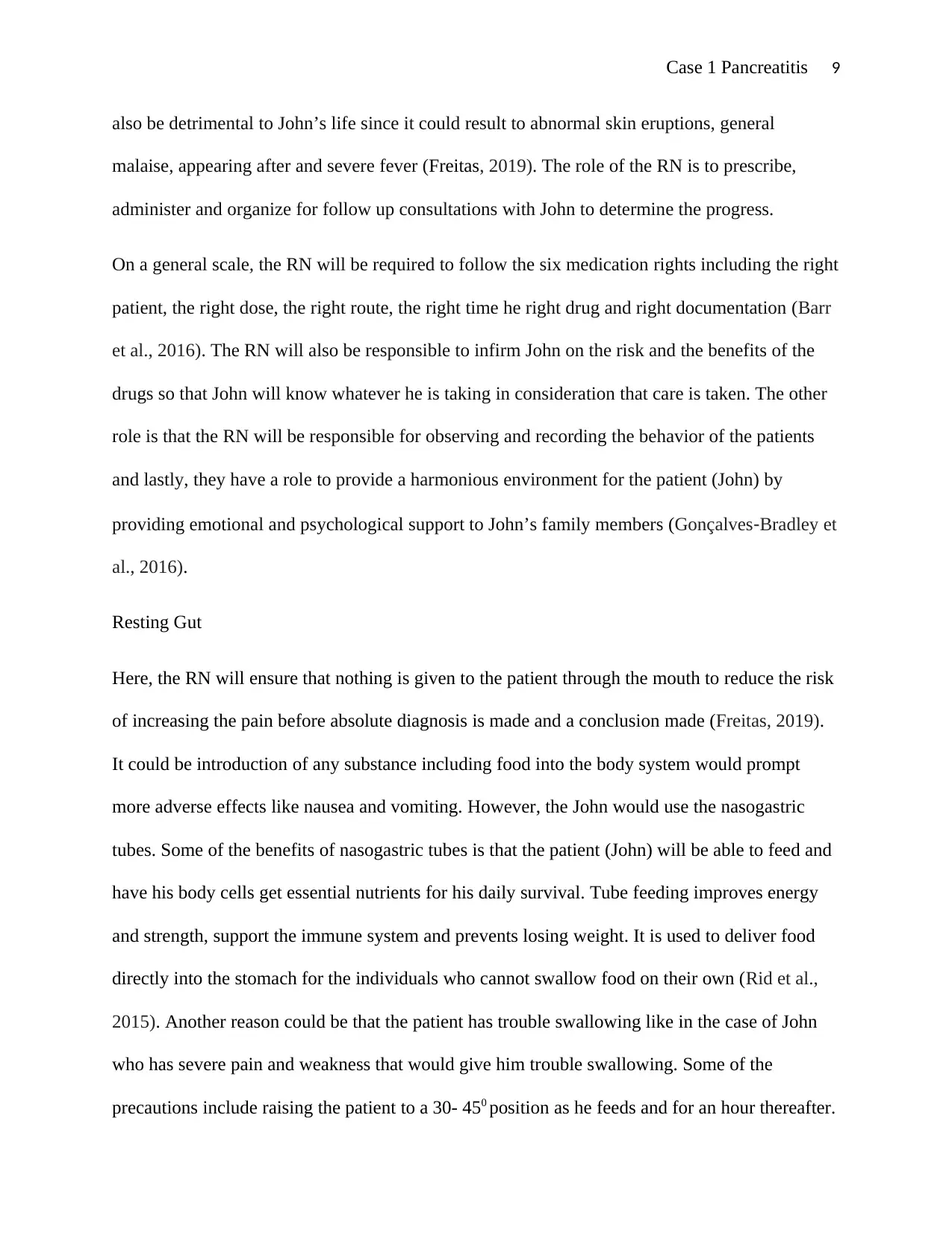
Case 1 Pancreatitis 9
also be detrimental to John’s life since it could result to abnormal skin eruptions, general
malaise, appearing after and severe fever (Freitas, 2019). The role of the RN is to prescribe,
administer and organize for follow up consultations with John to determine the progress.
On a general scale, the RN will be required to follow the six medication rights including the right
patient, the right dose, the right route, the right time he right drug and right documentation (Barr
et al., 2016). The RN will also be responsible to infirm John on the risk and the benefits of the
drugs so that John will know whatever he is taking in consideration that care is taken. The other
role is that the RN will be responsible for observing and recording the behavior of the patients
and lastly, they have a role to provide a harmonious environment for the patient (John) by
providing emotional and psychological support to John’s family members (Gonçalves‐Bradley et
al., 2016).
Resting Gut
Here, the RN will ensure that nothing is given to the patient through the mouth to reduce the risk
of increasing the pain before absolute diagnosis is made and a conclusion made (Freitas, 2019).
It could be introduction of any substance including food into the body system would prompt
more adverse effects like nausea and vomiting. However, the John would use the nasogastric
tubes. Some of the benefits of nasogastric tubes is that the patient (John) will be able to feed and
have his body cells get essential nutrients for his daily survival. Tube feeding improves energy
and strength, support the immune system and prevents losing weight. It is used to deliver food
directly into the stomach for the individuals who cannot swallow food on their own (Rid et al.,
2015). Another reason could be that the patient has trouble swallowing like in the case of John
who has severe pain and weakness that would give him trouble swallowing. Some of the
precautions include raising the patient to a 30- 450 position as he feeds and for an hour thereafter.
also be detrimental to John’s life since it could result to abnormal skin eruptions, general
malaise, appearing after and severe fever (Freitas, 2019). The role of the RN is to prescribe,
administer and organize for follow up consultations with John to determine the progress.
On a general scale, the RN will be required to follow the six medication rights including the right
patient, the right dose, the right route, the right time he right drug and right documentation (Barr
et al., 2016). The RN will also be responsible to infirm John on the risk and the benefits of the
drugs so that John will know whatever he is taking in consideration that care is taken. The other
role is that the RN will be responsible for observing and recording the behavior of the patients
and lastly, they have a role to provide a harmonious environment for the patient (John) by
providing emotional and psychological support to John’s family members (Gonçalves‐Bradley et
al., 2016).
Resting Gut
Here, the RN will ensure that nothing is given to the patient through the mouth to reduce the risk
of increasing the pain before absolute diagnosis is made and a conclusion made (Freitas, 2019).
It could be introduction of any substance including food into the body system would prompt
more adverse effects like nausea and vomiting. However, the John would use the nasogastric
tubes. Some of the benefits of nasogastric tubes is that the patient (John) will be able to feed and
have his body cells get essential nutrients for his daily survival. Tube feeding improves energy
and strength, support the immune system and prevents losing weight. It is used to deliver food
directly into the stomach for the individuals who cannot swallow food on their own (Rid et al.,
2015). Another reason could be that the patient has trouble swallowing like in the case of John
who has severe pain and weakness that would give him trouble swallowing. Some of the
precautions include raising the patient to a 30- 450 position as he feeds and for an hour thereafter.
⊘ This is a preview!⊘
Do you want full access?
Subscribe today to unlock all pages.

Trusted by 1+ million students worldwide
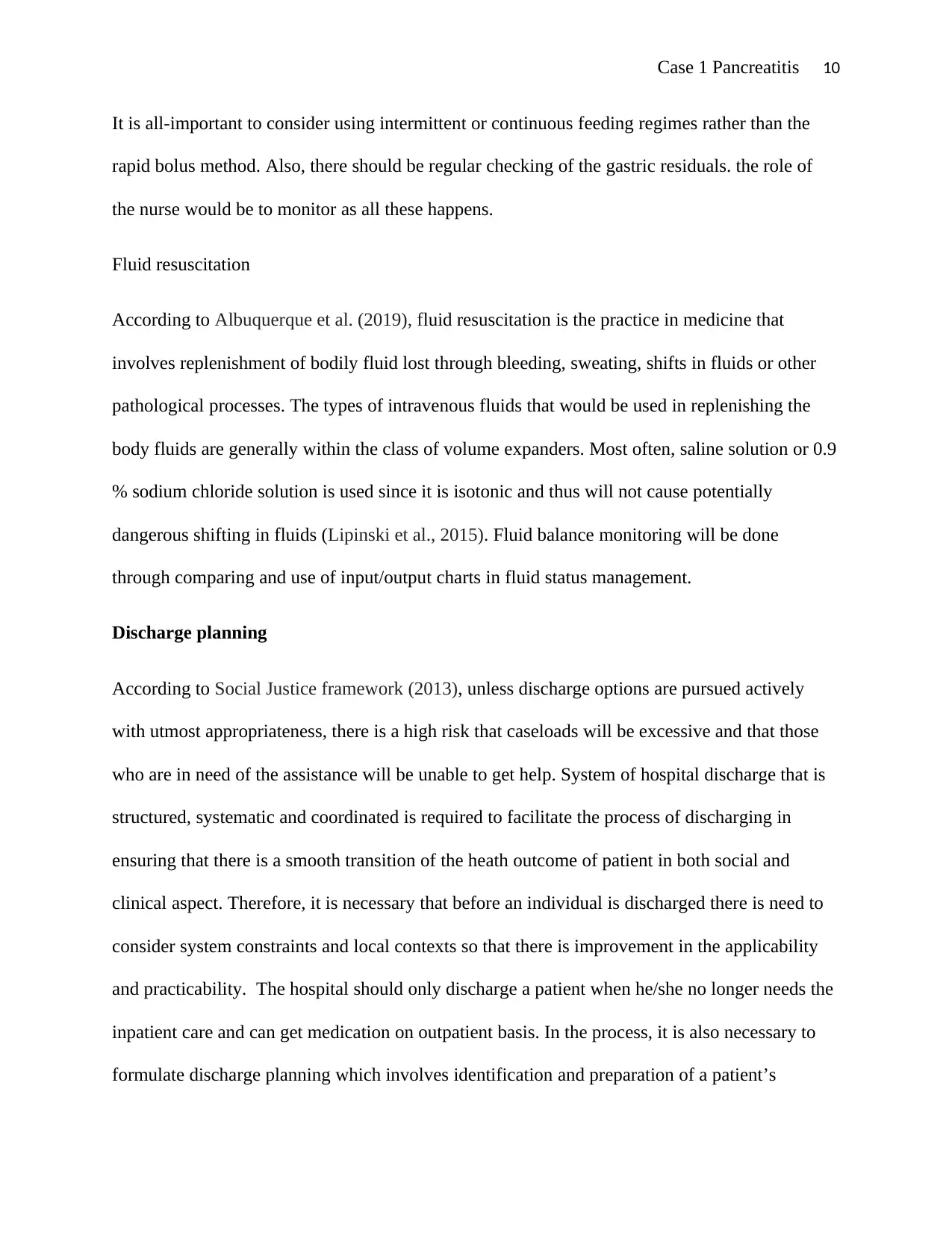
Case 1 Pancreatitis 10
It is all-important to consider using intermittent or continuous feeding regimes rather than the
rapid bolus method. Also, there should be regular checking of the gastric residuals. the role of
the nurse would be to monitor as all these happens.
Fluid resuscitation
According to Albuquerque et al. (2019), fluid resuscitation is the practice in medicine that
involves replenishment of bodily fluid lost through bleeding, sweating, shifts in fluids or other
pathological processes. The types of intravenous fluids that would be used in replenishing the
body fluids are generally within the class of volume expanders. Most often, saline solution or 0.9
% sodium chloride solution is used since it is isotonic and thus will not cause potentially
dangerous shifting in fluids (Lipinski et al., 2015). Fluid balance monitoring will be done
through comparing and use of input/output charts in fluid status management.
Discharge planning
According to Social Justice framework (2013), unless discharge options are pursued actively
with utmost appropriateness, there is a high risk that caseloads will be excessive and that those
who are in need of the assistance will be unable to get help. System of hospital discharge that is
structured, systematic and coordinated is required to facilitate the process of discharging in
ensuring that there is a smooth transition of the heath outcome of patient in both social and
clinical aspect. Therefore, it is necessary that before an individual is discharged there is need to
consider system constraints and local contexts so that there is improvement in the applicability
and practicability. The hospital should only discharge a patient when he/she no longer needs the
inpatient care and can get medication on outpatient basis. In the process, it is also necessary to
formulate discharge planning which involves identification and preparation of a patient’s
It is all-important to consider using intermittent or continuous feeding regimes rather than the
rapid bolus method. Also, there should be regular checking of the gastric residuals. the role of
the nurse would be to monitor as all these happens.
Fluid resuscitation
According to Albuquerque et al. (2019), fluid resuscitation is the practice in medicine that
involves replenishment of bodily fluid lost through bleeding, sweating, shifts in fluids or other
pathological processes. The types of intravenous fluids that would be used in replenishing the
body fluids are generally within the class of volume expanders. Most often, saline solution or 0.9
% sodium chloride solution is used since it is isotonic and thus will not cause potentially
dangerous shifting in fluids (Lipinski et al., 2015). Fluid balance monitoring will be done
through comparing and use of input/output charts in fluid status management.
Discharge planning
According to Social Justice framework (2013), unless discharge options are pursued actively
with utmost appropriateness, there is a high risk that caseloads will be excessive and that those
who are in need of the assistance will be unable to get help. System of hospital discharge that is
structured, systematic and coordinated is required to facilitate the process of discharging in
ensuring that there is a smooth transition of the heath outcome of patient in both social and
clinical aspect. Therefore, it is necessary that before an individual is discharged there is need to
consider system constraints and local contexts so that there is improvement in the applicability
and practicability. The hospital should only discharge a patient when he/she no longer needs the
inpatient care and can get medication on outpatient basis. In the process, it is also necessary to
formulate discharge planning which involves identification and preparation of a patient’s
Paraphrase This Document
Need a fresh take? Get an instant paraphrase of this document with our AI Paraphraser
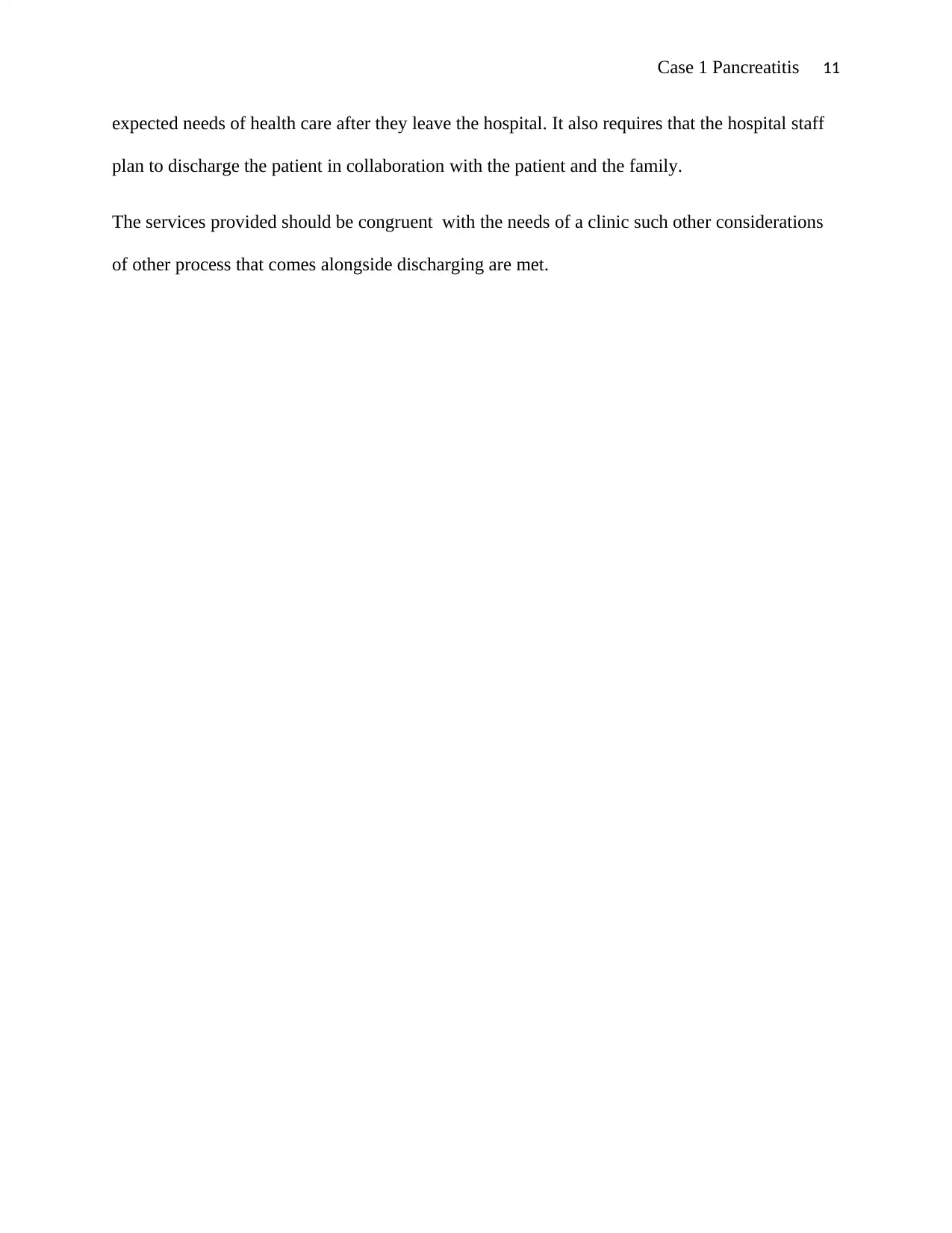
Case 1 Pancreatitis 11
expected needs of health care after they leave the hospital. It also requires that the hospital staff
plan to discharge the patient in collaboration with the patient and the family.
The services provided should be congruent with the needs of a clinic such other considerations
of other process that comes alongside discharging are met.
expected needs of health care after they leave the hospital. It also requires that the hospital staff
plan to discharge the patient in collaboration with the patient and the family.
The services provided should be congruent with the needs of a clinic such other considerations
of other process that comes alongside discharging are met.
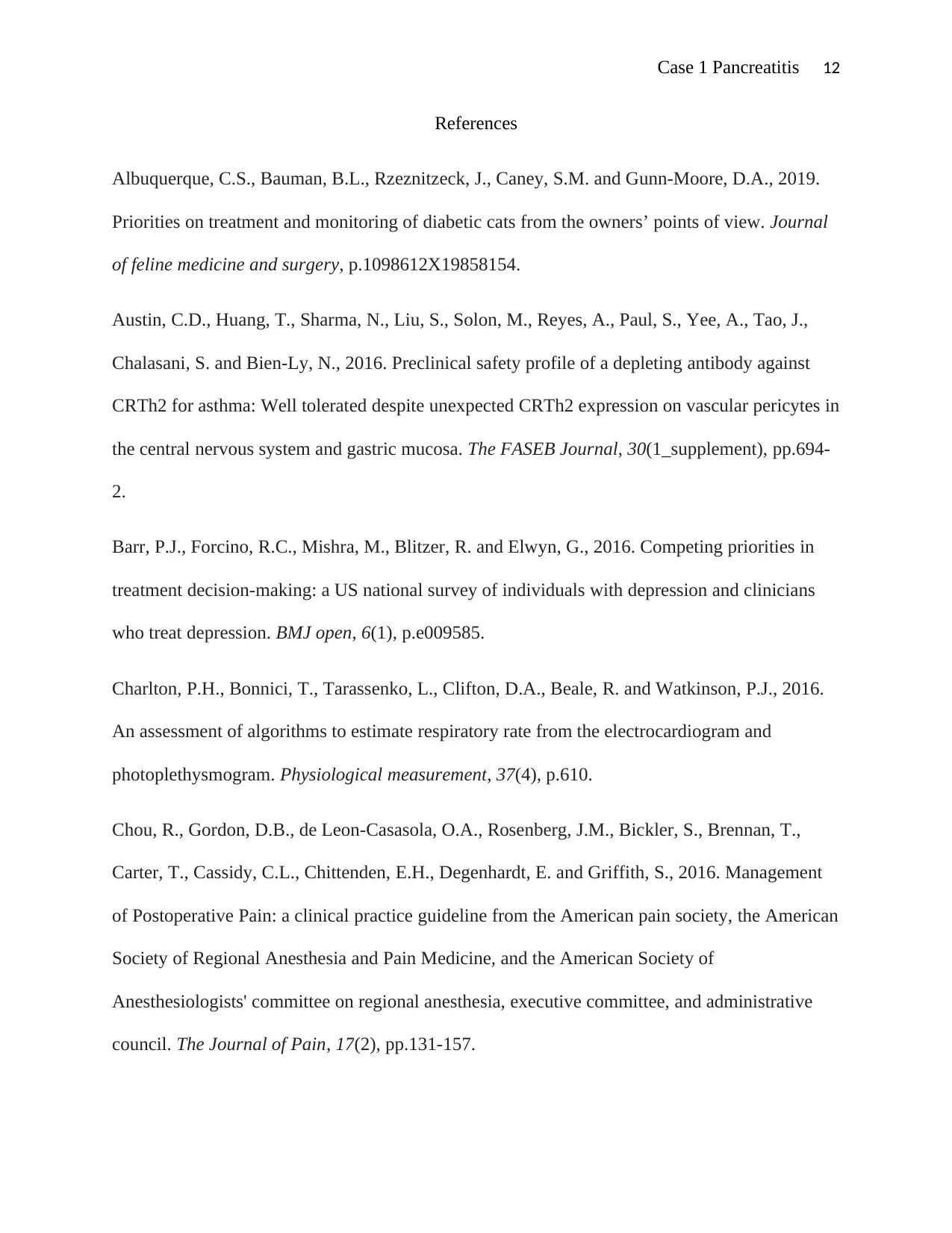
Case 1 Pancreatitis 12
References
Albuquerque, C.S., Bauman, B.L., Rzeznitzeck, J., Caney, S.M. and Gunn-Moore, D.A., 2019.
Priorities on treatment and monitoring of diabetic cats from the owners’ points of view. Journal
of feline medicine and surgery, p.1098612X19858154.
Austin, C.D., Huang, T., Sharma, N., Liu, S., Solon, M., Reyes, A., Paul, S., Yee, A., Tao, J.,
Chalasani, S. and Bien-Ly, N., 2016. Preclinical safety profile of a depleting antibody against
CRTh2 for asthma: Well tolerated despite unexpected CRTh2 expression on vascular pericytes in
the central nervous system and gastric mucosa. The FASEB Journal, 30(1_supplement), pp.694-
2.
Barr, P.J., Forcino, R.C., Mishra, M., Blitzer, R. and Elwyn, G., 2016. Competing priorities in
treatment decision-making: a US national survey of individuals with depression and clinicians
who treat depression. BMJ open, 6(1), p.e009585.
Charlton, P.H., Bonnici, T., Tarassenko, L., Clifton, D.A., Beale, R. and Watkinson, P.J., 2016.
An assessment of algorithms to estimate respiratory rate from the electrocardiogram and
photoplethysmogram. Physiological measurement, 37(4), p.610.
Chou, R., Gordon, D.B., de Leon-Casasola, O.A., Rosenberg, J.M., Bickler, S., Brennan, T.,
Carter, T., Cassidy, C.L., Chittenden, E.H., Degenhardt, E. and Griffith, S., 2016. Management
of Postoperative Pain: a clinical practice guideline from the American pain society, the American
Society of Regional Anesthesia and Pain Medicine, and the American Society of
Anesthesiologists' committee on regional anesthesia, executive committee, and administrative
council. The Journal of Pain, 17(2), pp.131-157.
References
Albuquerque, C.S., Bauman, B.L., Rzeznitzeck, J., Caney, S.M. and Gunn-Moore, D.A., 2019.
Priorities on treatment and monitoring of diabetic cats from the owners’ points of view. Journal
of feline medicine and surgery, p.1098612X19858154.
Austin, C.D., Huang, T., Sharma, N., Liu, S., Solon, M., Reyes, A., Paul, S., Yee, A., Tao, J.,
Chalasani, S. and Bien-Ly, N., 2016. Preclinical safety profile of a depleting antibody against
CRTh2 for asthma: Well tolerated despite unexpected CRTh2 expression on vascular pericytes in
the central nervous system and gastric mucosa. The FASEB Journal, 30(1_supplement), pp.694-
2.
Barr, P.J., Forcino, R.C., Mishra, M., Blitzer, R. and Elwyn, G., 2016. Competing priorities in
treatment decision-making: a US national survey of individuals with depression and clinicians
who treat depression. BMJ open, 6(1), p.e009585.
Charlton, P.H., Bonnici, T., Tarassenko, L., Clifton, D.A., Beale, R. and Watkinson, P.J., 2016.
An assessment of algorithms to estimate respiratory rate from the electrocardiogram and
photoplethysmogram. Physiological measurement, 37(4), p.610.
Chou, R., Gordon, D.B., de Leon-Casasola, O.A., Rosenberg, J.M., Bickler, S., Brennan, T.,
Carter, T., Cassidy, C.L., Chittenden, E.H., Degenhardt, E. and Griffith, S., 2016. Management
of Postoperative Pain: a clinical practice guideline from the American pain society, the American
Society of Regional Anesthesia and Pain Medicine, and the American Society of
Anesthesiologists' committee on regional anesthesia, executive committee, and administrative
council. The Journal of Pain, 17(2), pp.131-157.
⊘ This is a preview!⊘
Do you want full access?
Subscribe today to unlock all pages.

Trusted by 1+ million students worldwide
1 out of 14
Related Documents
Your All-in-One AI-Powered Toolkit for Academic Success.
+13062052269
info@desklib.com
Available 24*7 on WhatsApp / Email
![[object Object]](/_next/static/media/star-bottom.7253800d.svg)
Unlock your academic potential
Copyright © 2020–2025 A2Z Services. All Rights Reserved. Developed and managed by ZUCOL.





